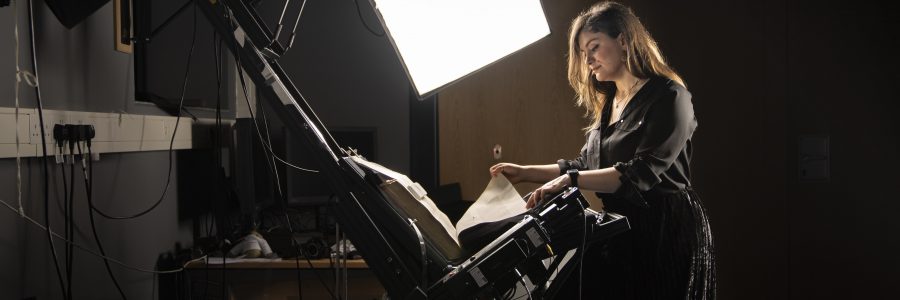
Two Decades of Digital Photography in the Library: Evolution of Practice and Technology
Post by Maciej M. Pawlikowski, Head of Digital Content Unit, and Raffaella Losito, Photographer
When photographers are working on the digitisation of special collections, they often come across their own institution’s historical photographs of the same books and objects. All those versions are not only valuable evidence of any changes in the items’ physical conditions, but also historical evidence of developments in photographic practice. When we compare old black-and-white photographs with modern colour images, the difference is striking, but differences between digital images are much more subtle. Such comparisons require highly specialised examination of imaging techniques, equipment, and methodologies, which reach deeply into the technical aspects of image creation.
This blogpost presents as a case study one such comparison which we made during a current major digitisation project based at Cambridge University Library: Curious Cures in Cambridge Libraries is a Wellcome-funded project to digitise, catalogue and conserve over 180 medieval manuscripts that contain unpublished medical recipes.
One of the project manuscripts – Cambridge, Magdalene College, Pepys MS 1236 – was already photographed in 2003 by Dr Julia Craig-McFeely, Project Manager of the Digital Image Archive of Medieval Music (DIAMM[1] – University of Oxford) since 1998 and its Director since 2007.[2] At the time, DIAMM was one of only a few digitisation projects in existence.
What has changed?
Camera equipment
In the early years of the DIAMM project, the only option available for achieving good results was the so-called Phase One Digital Scanning Back. The latter is a scanning device that the photographers attached to a Fuji medium format camera at the location where its film holder is situated. They would also pair it with a Hasselblad macro lens. (Fig. 1). The PODSB’s linear scanning sensor would take a photo by moving across the back of the lens (just like in a photocopier), slowly registering an image line by line. There were limitations to this method. One scan could take about five to six minutes, but in extreme cases as long as ten minutes, all to acquire just one photograph.
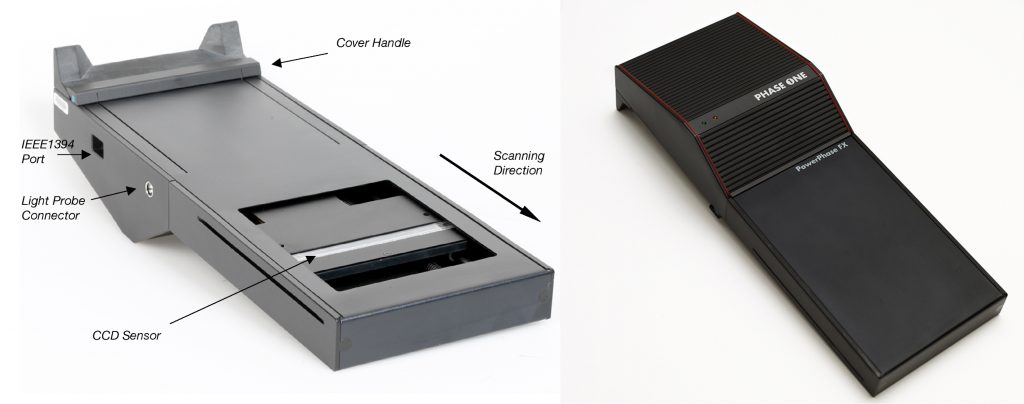
Twenty years later, at Cambridge University Library, we also work with Phase One Camera systems, but the technology has changed dramatically: we benefit from the latest version of the XF single-shot camera system. Thanks to the improved medium format camera sensor and high-quality optics, we are producing the best possible images. Nowadays, the biggest difference between this system and the old one is in the velocity: it takes 1/125 of a second to capture an image so the only limitation is the time spent on handling the manuscripts and managing other photography-related tasks. In other words, on average we can create three times more images in the same period.
Imaging protocols and environment
The first widely adopted imaging standards were introduced only in 2010.[3] Before this time, digitisation projects such as DIAMM had to devise their own imaging protocols — a process that required much preparation and research before they could begin.
Today we follow a set of internally created imaging protocols that correspond with international standards. These are based on the same principles as those set by DIAMM for calibrating the photographic scene and ensuring lighting consistency. Like DIAMM, we make sure that the shooting surface is at a specific distance from the camera in order to create an accurate detail reproduction at a 1:1 scale. This procedure is often referred to as ‘reproduction scale accuracy’ which is described in Pixels Per Inch (PPI) or Dots Per Inch (DPI). In other words, the scale is measured by the number of points that are used to reproduce an inch of a physical object. The scale of 600 PPI is the industry standard. For comparison, 300 DPI is what printers usually require for creating a good facsimile.
But there are differences with the DIAMM project as well. Firstly, DIAMM used the best possible resolution for each manuscript by framing the manuscript page to make maximum use of all available pixels. For Pepys MS 1236 this was 1175 PPI, almost double the PPI of what is now the recommended practice. Moreover, whereas DIAMM was working with portable equipment in a variety of challenging environments, we can provide extremely consistent imaging conditions by working with a robust stationary system. This simply makes modern processes time efficient and effective.
Like DIAMM, modern-day photographers use specialised software to train the camera to register the correct colours of an object in specific lighting conditions. In doing so, we create consistent, documented, and reproducible results. The colour-managed environment of such calibrated computer monitors, also allows us to examine the results, because all imaging standards rely on both measurements and visual assessment by a skilled professional.
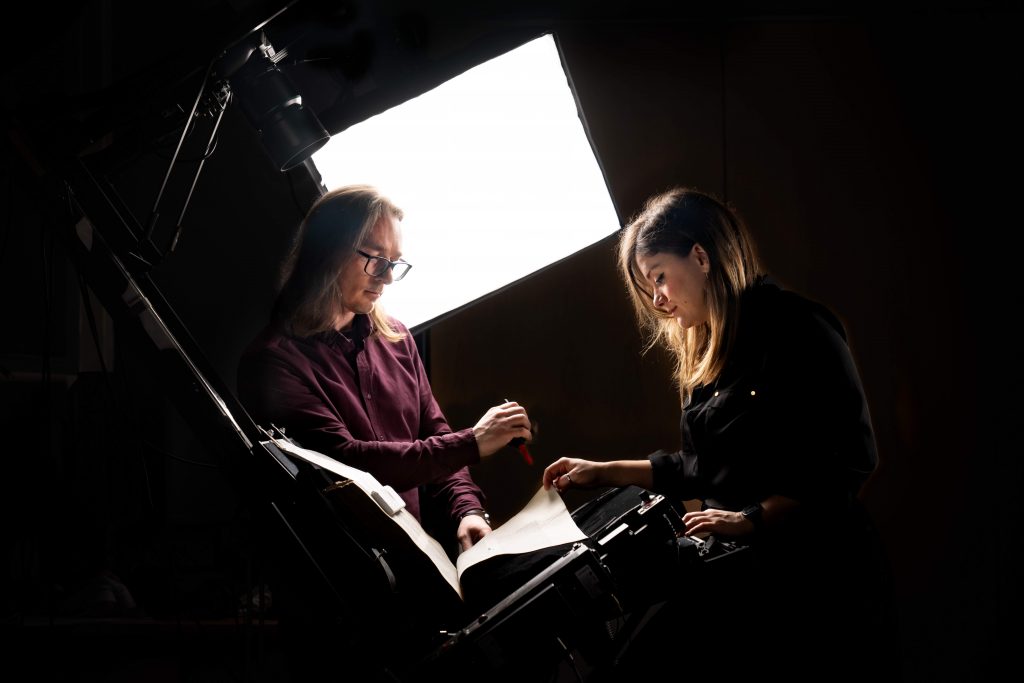
How do the images compare?
In theory, the quality of digital images can be entirely analysed by computers: since a digital image is an object constructed as a series of numbers ordered in a structure that is visually represented through the computer interface, these numbers can be used to calculate whether the measurements of digital reproductions correspond with those of their originals. In these terms, archival imaging is a photographic process where we employ a set of tools to translate captured images with a view to create a digital reproduction that is as close to the original material as possible. Nevertheless, visual assessment remains the end point of any digitisation process in all archival imaging standards. For this reason, we will focus on what differences between old and new images are most visible to the trained photographer’s eye.
When comparing old and new images, it is worth noting that even with the most rigid protocols of archival reproduction, the particular experiences of photographers and institutional practices might influence what we see as a result. However, some characteristics of images are determined by the type of imaging system — such as the type of a camera sensor or lens — which will vary from one camera model to another. Comparison of these characteristics perhaps best illustrates how technology has evolved in the past two decades.
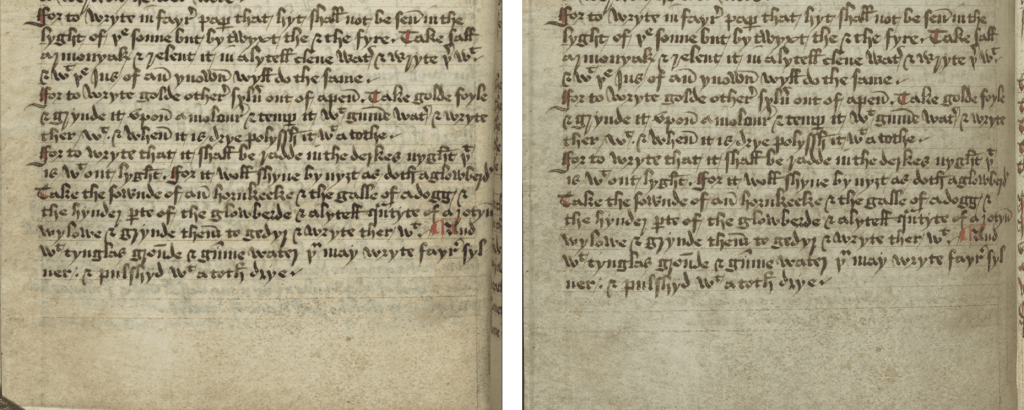
At first glance, the images of Pepys MS 1236 produced by DIAMM (2003) and those produced today (2023) look very similar (Fig. 2). The skin tones of the parchment are reproduced in both images as well. But there is slightly more tonal variation in the reproduction of the ink in the 2023 images: there is more intensity in the reproduction, one can detect patterns in the ink distribution, and the texture of the parchment is also more pronounced. More generally, the images from 2003 seem to show slightly more contrast. Two major factors may be responsible for the latter difference.
Firstly, in the early days of digital photography, the digital output images were designed to imitate the products of film photography. Each brand and model of photographic film would have its own characteristic contrast response. This was usually represented as the “S”-shaped curve.[4] Nowadays, digital cameras reproduce the same “Curve” feature but it can be altered later during post-processing. As a part of the modern camera calibration process, we strive to start from the “linear response” curve, where minimal contrast is applied.
Secondly, dynamic range is a factor that affects the image and is partially responsible for how much contrast exists in the visual representation. In photography, dynamic range is the difference between the darkest and brightest values that a camera can register in a single exposure. In other words, it is about the precision with which light can be captured. Therefore, the dynamic range of the image is resolved by the lens and the camera’s photosensor. Modern camera equipment is designed to achieve higher dynamic range and capture more tonal differences which can result in less contrasted images.
For this reason, when we study both old and new digital images at 100x magnification and look at how each pixel corresponds to a dot of a computer screen, we can see some discrepancy in detail reproduction (Fig. 3).
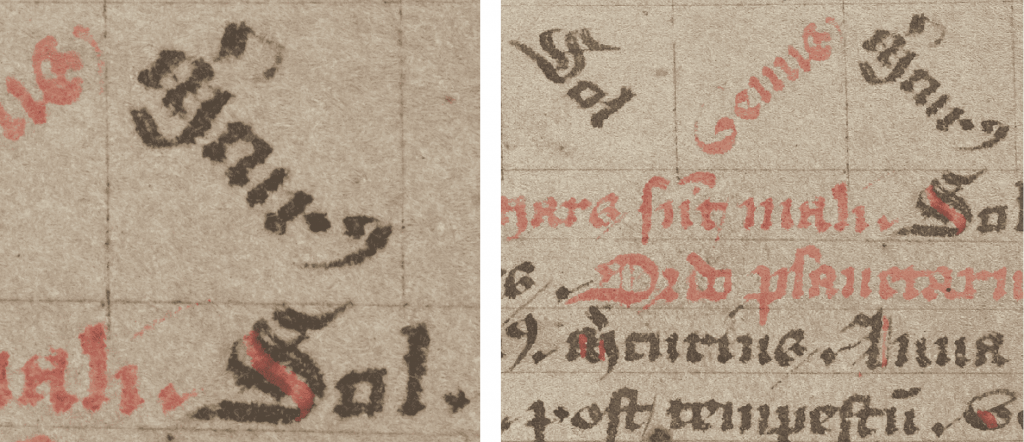
When looking at the images above, one image seems to be at a greater magnification than the other. While the Phase One Scanning Back produced an equivalent of 130 Megapixels (MP) resulting in the reproduction of a manuscript in 1175 PPI, we are using a 100 MP scanning back with 750 PPI at a 1:1 scale. Consequently, the older images have many more pixels. Although having more pixels does not guarantee a more detailed result, this proved to be a clever decision on the part of the DIAMM project team: by using the best possible technology at the time and obtaining the highest possible resolution, they created future-proof digital objects that were fit for purpose and lasted much longer than many other digitisation endeavours of that time. When we scale both the old and new images to produce a comparable view of the manuscript (Fig. 4), the reproduction of details on the page is of a comparable standard.
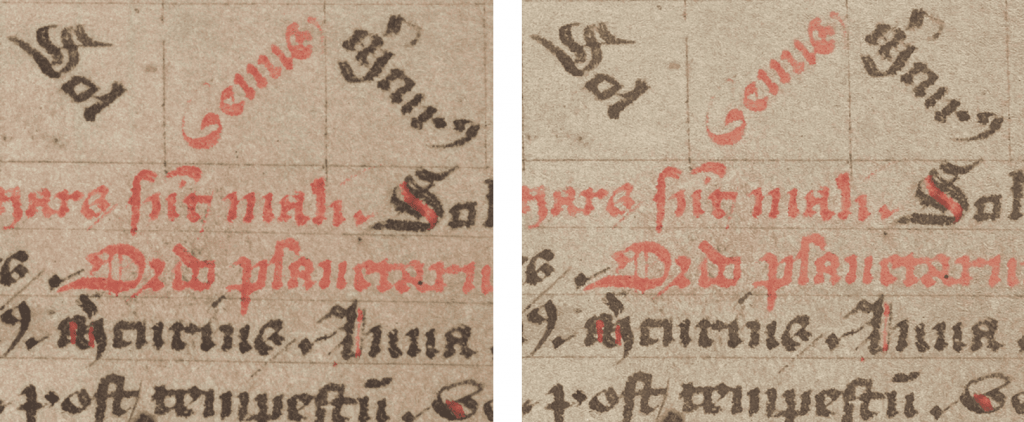
What’s Next?
Two decades of digital imaging in heritage environments has taught us a lot and helps us to think confidently about the future of this discipline. In recent years, cultural heritage imaging has evolved beyond simple photography and migrated to the realms of science, expanding the classical definition of imaging to encompass an extensive range of scientific methodologies. Although these new realms are incredibly exciting, it is important not to forget the lessons learnt.
Our understanding of technology has made us more aware of its benefits and associated risks. Standardising principles and introducing robust guidelines has helped us to accommodate digitisation projects. But with the arrival of every new method or more advanced system, we need to bear in mind its technical limitations and know that further improvements to the technology are only around the corner. We can, and should, mitigate some of these risks when planning and designing future digitisation projects. If we were to photograph the Curious Cures manuscripts in the same resolution as the DIAMM project, we would use about 8 terabytes (TB) of storage space. Because this would create a significant carbon footprint and the maintenance costs of keeping the preservation master files would be high, we take our photographs at a lower resolution. This means that we only need about 4 TB of storage space. Importantly, new technical developments allow us to do this without compromising the quality of our images.
Digital images are collection items in their own right — artefacts that bear witness not only to the materiality of medieval manuscripts and other historical objects, but also to the process of those objects’ digitisation and the equipment, techniques and skills that were employed to that end. The images created by DIAMM and Curious Cures add to the layers of history of a manuscript, in the same way that records of its ownership and provenance or the recording of repairs and interventions by our colleagues in the Conservation & Collection Care department do. For heritage photographers, the images produced by DIAMM are a precious record of the work of digital pioneers who laid the foundation for our own work twenty years later.
Twenty years of improving technology have changed the role of the heritage photographer and allowed us to develop a niche discipline that has become increasingly technical and scientific. We understand the digital imaging process on a different level than our colleagues working in fashion or portrait photography. Digital imaging has worked in the service of academic study, providing reproductions of heritage artefacts that enable scholarly research. Heritage photographers have become increasingly active participants in academic projects by mediating technologies to extract information from the manuscripts that researchers cannot access independently.
[1] www.diamm.ac.uk [accessed: 23 January 2023]
[2] ‘The real cost of acquiring pictures for the Digital Image Archive of Medieval Music (DIAMM)’, The Soul of Wit. Micro-Festschrift Rob Wegman zum 50. Geburtstag, edited by Michael Scott Cuthbert (Somerville/Mass., 2011), 12r
[3] https://www.digitizationguidelines.gov/guidelines/digitize-technical.html [accessed: 23 January 2023]
[4] https://www.ilfordphoto.com/amfile/file/download/file/1948/product/1658/ [accessed: 23 January 2023]

Interesting article- brings back memories from the days of scan backs…. how far we’ve come!
Thank you for your generous comments about DIAMM! We’re still at it, now using the latest PhaseOne single-shot cameras, so around 160Mpx. The technology has certainly moved on a lot! Good article and very interesting comparison of images takes so far apart in time. In 2003 I wasn’t able to work in a dark room to get optimum colour control because of having to work in the reading room of the library, but it’s good to see the images stand up to scrutiny even so. Thank you again for your kind words.